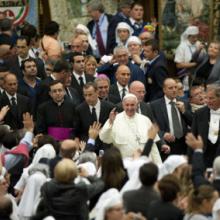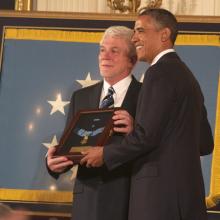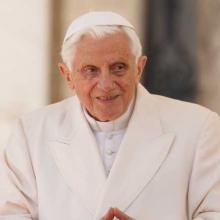roman catholic church
LEONARDO BOFF’S Francis of Rome and Francis of Assisi: A New Springtime for the Church offers intriguing portraits of the current bishop of Rome and the saint that is his namesake. The book provides an introduction to these two extraordinary figures and includes a brief overview of the papacy, tracing how the office of the bishop of Rome eventually became the infallible pope.
The Roman Catholic Church depicted through Boff’s eyes is a church in crisis, reeling from the Vatican Bank and clergy sex abuse scandals. The institution and leadership have lost credibility in the eyes of many and the Roman curia is in need of reform. Yet this crisis is tempered by the election of Jorge Mario Bergoglio as pope, which for Boff fuels a tangible optimism for the church’s future.
Both men in these pages are called to the work of reform. Francis of Assisi’s conversion began when he heard a crucifix in a small church say, “Francis, go and restore my house, because it is in ruins.” Boff depicts Pope Francis as receiving a similar call, to reform the church so that it becomes a church that is poor, emphasizing humility and charity. Boff raises both men as models of living with the poor and like the poor, citing the now famous example of Francis going to pay his hotel bill after being elected pope.
In demoting American Cardinal Raymond Burke from his powerful perch at the Vatican, Pope Francis has sidelined an outspoken conservative agitator – for now.
The pope moved the feisty former archbishop of St. Louis from his role as head of the Vatican’s highest court to the largely ceremonial position of patron of the Knights of Malta on Nov. 8.
Francis has effectively exiled one of his loudest critics, but Burke’s supporters – and his opponents – warn that his position at the Catholic charity may actually give him more freedom to exercise greater influence and even rally opposition to papal reforms.
In other words, the stunning demotion may remake Burke into St. Raymond the Martyr, the patron saint of Catholic conservatives.
“His position as patron of the Knights of Malta is Rome-based and mostly ceremonial,” wrote Edward Pentin for the conservative National Catholic Register.
“He is nevertheless likely to continue and perhaps even step up his defense of the Church’s teaching in the face of continued efforts to radically alter pastoral practice in the run-up to next year’s second synod on the family.”
Burke is well-known for his uncompromising stance on abortion, homosexuality and the sanctity of marriage, and his passion for doctrine is matched only by his passion for the elegant finery of his office.
The Archdiocese of New York, with the second-largest Catholic population in the country and an unparalleled place in U.S. church history, is shrinking: Cardinal Timothy Dolan on Nov. 2 announced that nearly a third of the archdiocese’s 368 parishes would be merging, and some would close.
“This time of transition in the history of the archdiocese will undoubtedly be difficult for people who live in parishes that will merge,” Dolan said in a statement. “There will be many who are hurt and upset as they experience what will be a change in their spiritual lives, and I will be one of them.”
The reorganization was years in the making and some downsizing appeared inevitable, as happened in the last round of cutbacks, in 2007. While the sprawling archdiocese is still home to 2.8 million Catholics, fewer of them are attending Mass or Catholic schools, and costs are rising. The archdiocese said it is spending $40 million a year to prop up failing or redundant parishes.
Still, the extent of the changes, the largest in the more than 200-year history of the archdiocese, upset many Catholics, especially in neighborhoods where waves of immigration had built and revived parishes across the decades.
“I feel very sad; I was baptized here,” Sonia Cintron, 75, a member of the Church of the Holy Rosary in East Harlem, told The New York Times. “Here we’re family; we loved each other.”
Some parishioners have vowed to try to keep their churches open through petitions and protests.
This weekend, more than 800,000 spectators crowded the St. Peter’s Square area while 500,000 more watched on giant screens around Rome as Pope Francis canonized Pope John XXIII and Pope John Paul II. The first time a pope has sainted two popes at the same time, this historic event has been called a savvy political move by the media, since Pope Francis recognized both the more liberal John XXIII and the more conservative John Paul II, thus satisfying two opposing wings of the Roman Catholic church. While Pope Francis did indeed display political savvy at this canonization, this event holds far more significance than that (even leaving aside the spiritual question of discerning sainthood).
When Pope Francis canonizes Popes John XXIII and John Paul II on Sunday, Catholics across the spectrum will have reason to cheer: Liberals credit John with opening the church to the modern world in the 1960s, and conservatives hail John Paul as reasserting orthodoxy after too many innovations.
But the unprecedented double-barreled canonization also raises a question that might give both sides pause: Why is Rome making saints of almost every modern pontiff after nearly a millennium when almost no popes were canonized?
In the first 500 years of Christianity, the Apostle Peter (considered the first pope by tradition) and 47 of his 48 papal successors were viewed as saints, mainly because so many of them were martyred, which is the simplest route to canonization. Another 30 popes were named saints in the next 500 years, largely based on their reputation for sanctity.
As the anniversary of his surprising resignation approaches, Pope Benedict XVI has rejected as “simply absurd” the speculation that he was forced to step down, and he said he still wears the distinctive white papal cassock for “purely practical reasons.”
“At the moment of my resignation there were no other clothes available,” Benedict wrote in a brief letter to an Italian journalist that was published on Wednesday.
The emeritus pope also said that he kept the name Benedict, rather than reverting to his birth name of Joseph Ratzinger, because it was a simple solution.
African church leaders are urging parties in the South Sudanese conflict to respect places of worship, after rebels attacked and looted church compounds in the town of Malakal.
The Roman Catholic Cathedral of Malakal was looted at gunpoint, forcing priests, and civilians to flee, a regional church leader said.
Catholic and Presbyterian churches, a hospital and an orphanage have become safe havens for refugees escaping the fighting in the city.
“I came to know myself what it means to be asked for something under the threat of a gun when a group in uniform stopped me on the way from the hospital to the church,” said one Catholic priest, who did not give his name because he fears for his safety. “They blocked me and took my watch and a key.”
First, the name “Francesco” leapfrogged to No. 1 on the list of the most popular baby names in Italy.
Then, the city of Rome reported a tourism boom, mostly from Latin America.
Now, there’s word Roman Catholic Church attendance is climbing throughout Italy.
Blame it on “the Francis effect.”
Italy’s Center for Studies on New Religions reported Sunday that around half of the 250 priests it surveyed reported a significant rise in church attendance since Cardinal Jorge Mario Bergoglio became Pope Francis in March.
The $20,000 bathtub and $482,000 walk-in closets ordered by “Bishop Bling-Bling” — the moniker of Franz-Peter Tebartz-van Elst, the now-suspended bishop of Limburg — have scandalized the German public.
But Tebartz-van Elst, 52, is only the latest German clergyman to run into trouble since Pope Francis took the helm of the Roman Catholic Church. Francis temporarily suspended the bishop on Wednesday while a church commission investigates the expenditures on the $42 million residence complex.
As the new pontiff tries to reform the way the church does business, German dioceses, which reportedly include the world’s wealthiest in Cologne, are chafing under the new direction as membership numbers continue to dwindle.
Schismatic Roman Catholic priests, who left the church to claim their right to marry, are now asking for an “African pope” to lead them.
The priests say they regret their former church is “allergic” to change. They believe priestly celibacy is neither rooted in the teachings of Jesus nor in the work of his apostles, who were married. And they insist celibacy does not work in an African context.
Former Zambian Archbishop Emmanuel Milingo who married a Korean acupuncturist in a 2001 celebration sponsored by the Unification Church and presided by its late founder, the Rev. Sun Myung Moon, serves as “African patriarch” of a number of church groups affiliated with his movement.
England and Wales became the 16th and 17th countries in the world to recognize gay marriage after Queen Elizabeth II gave “royal assent” to a same-sex marriage bill.
Under the new law, gay men and women will be able to join together in civil ceremonies or in church services — although no religious denomination will be forced to carry out such services.
Cheers, laughter, and clapping broke out in the House of Commons when Speaker John Bercow announced the bill had been approved.
It’s not the message you might expect to hear from Rick Santorum, the Christian-conservative former presidential candidate: Faith-based films tend to be lousy, and Christians should quit trying to lock modern popular culture out of their lives.
Instead, Santorum says, Christian conservatives should acknowledge that modern popular culture is here to stay, and use that platform to produce Christian-themed films that will also have quality and popular appeal. It’s a strategy he says he intends to pursue in his new role as CEO of a ground-breaking faith-based film studio.
In an interview here, Santorum also stood by his strong views against same-sex marriage, citing the necessity to adhere to religious teachings — but then disputed his own religion’s leaders on the issue of immigration.
Gay Americans are much less religious than the general U.S. population, and about 3-in-10 of them say they have felt unwelcome in a house of worship, a new study shows.
The Pew Research Center’s study, released Thursday, details how gay, lesbian, bisexual, and transgender Americans view many of the country’s prominent faiths: in a word, unfriendly.
The vast majority said Islam (84 percent); the Mormon church (83 percent); the Roman Catholic Church (79 percent); and evangelical churches (73 percent) were unfriendly. Jews and nonevangelical Protestants drew a more mixed reaction, with more than 40 percent considering them either unfriendly or neutral about gays and lesbians.
A candidate for sainthood in the Roman Catholic Church was posthumously awarded the Medal of Honor by President Obama Thursday at the White House.
The Rev. Emil Kapaun, a priest who served as an Army chaplain in the Korean War, was recognized for his bravery on the battlefield and in a prisoner-of-war camp.
During battles, Kapaun would run into enemy fire to save wounded Americans or comfort the dying. When he was captured and taken to a prisoner-of-war camp, he defied the guards in order to care for other soldiers, physically and spiritually, until he died in 1951.
Roman Catholic cardinals on Monday met for the first of a series of closed-door meetings in the run-up to the conclave that will elect the successor to former Pope Benedict XVI.
But as cardinals filed into a Vatican conference room under the gaze of dozens of cameras, church officials said 12 voting prelates still haven’t arrived in Rome, pushing back the possibility of an early start to the conclave.
You won’t find many Catholic churches named after Pope Benedict IX.
Benedict IX squandered the papacy’s moral and financial riches in bordellos and banquet halls. His violence and debauchery “shocked even the Romans,” said philosopher Bertrand Russell, which is kind of like being busted for lewdness in Las Vegas. He was a puppet pope, installed by his powerful family at a time when rival clans ruled Rome. The young man seemed uninterested in religious life, rushing through ordination only after his election to the Throne of St. Peter in 1032.
St. Peter Damian called Benedict IX a "demon from hell in the disguise of a priest." The Catholic Encyclopedia labels him a “disgrace to the chair of St. Peter.” He was the first Pope Benedict to resign, selling the papacy for gold in order to marry. He later tried to reclaim the holy office and served three stints as pope between 1032 and 1048.
Nearly a millennium later, the pious and bookish Pope Benedict XVI seems completely contrary to his notorious namesake. Even if his papacy has stumbled at times, by all accounts the current Benedict has led a chaste life devoted to serving his church.
When the Alabama legislature passed their infamous, anti-immigrant law (HB 56), the religious community in the state immediately cried foul. Jim Wallis and other national leaders condemned the law as unjust and immoral.
HB 56, which will go into effect September 1, attacks virtually every aspect of immigrants' lives. Among many punitive measures, it authorizes police to detain anyone they suspect is undocumented, mandates criminal penalties for those who transport undocumented migrants, and demands that public schools determine the immigration status of all students.














